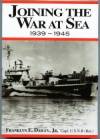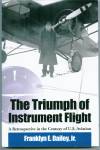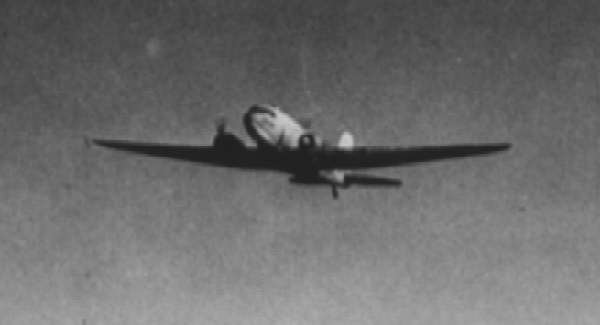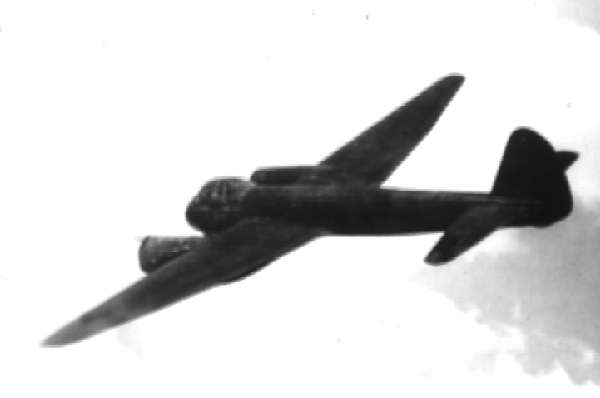
-------
.

Read The Triumph of Instrument Flight
- Navy Aerial Reconnaissance
- Warships at Morocco-1942
- Aircraft Carriers for Torch
- Battle for Morocco
- Bridging World Wars
- Supply and Support
- Husky, Palermo, Messina
- Bloody Salerno
- Luftwaffe Standoff Weapons
- Aircraft of World War II-"friendlies"
- Long "slog" at Anzio
- USS West Point AP23 War Cruise-part 1
- USS West Point AP23 War Cruise-part 2
- Singapore, Fateful Stop on "Joan's Journey"
- Update West Point
- Part I, Briggs on Casablanca, Sicily
- Part II, Briggs on Anzio
Sicily Invaded; Patton calls on Navy guns; Panzer Tanks repelled at Gela. Race to Straits of Messina won by Germans
Copyright 2011
Ships and Aircraft of World War II(many photos from U.S. Navy WW 2 Recognition Training Slide Set)

The above dispatch is a congratulatory message that Comcrudiv 8 relayed from the cruiser USS Birmingham CL-62, on July 20, 1943, to destroyer Edison. This new Cleveland class(very similar to the Brooklyns) light cruiser had just been commissioned in January 1943. My destroyer, the USS Edison, DD-439 was assigned screening duties for Birmingham off Porto Empodocle after giving fire support for General Truscott's 3rd Infantry Division and U.S. Rangers at Licata on Operation HUSKY on D-day, July 10, 1943. The heaviest amphibious action for the U.S. at Sicily had occurred in the center landings at Gela; this meant that the 3rd Division on the left (northwest, geographically) could move rapidly to take Palermo and then race to the Straits to try to cut off the retreating Germans. Despite the speed of Truscott's advancing forces, German General Kesselring had already decided, from the moment he authorized German troops to go into Sicily to help the Italians defend that island, to make his main stand in Italy itself. German tanks and infantry were ready with a planned pullback.

This is the Douglas C-47, as designated by the U.S. Army Air Corps in WW II. It was the R4D to the Navy, and a DC-3 in civil aeronautics. The shot came from the Navy recognition photoslide set, used to train shipboard personnel the difference between friend and foe. In addition to logistics duties in all theatres of WW II, this aircraft was the primary vehicle used for drops of paratroopers. First major use came at HUSKY, the invasion of Sicily on July 10, 1943. The day before the invasion, the Tyrrhenian Sea was hit by a sudden and violent storm. That sea is rimmed with land at close hand, and like one of the U.S. Great Lakes, can kick up into huge waves in short order. The armada of landing craft underway from North Africa, particularly those from Lake Bizerte in Tunisia destined for the JOSS operation at Licata, received their Beaufort baptism. LCVPs, LCIs, LCTs and even the big LSTs pitched and yawed. My destroyer circulated among them, more an effort at moral support than anything else. In the smaller craft, soldiers of General Lucian Truscott's Third Division were losing it over the side, almost impervious to any fear of actually being washed over the side. That evening, armadas of C-47s with thousands of paratroops, groped their way toward Sicily, subject to the same storm. Many were way off course. Even though forewarnings of C-47 flawed navigation finally reached the task force commanders at sea, it was way too late to inform many of the landing craft now approaching a hostile shore. With their light AA weapons, many opened fire upon seeing unexpected aircraft overhead. Many troopers and pilots were lost in one of WW IIs tragic episodes.

This is the German JU-88 aircraft from another Navy recognition photoslide.
With the 3rd Infantry Division racing to cut the German retreat from Sicily off before the latter could get back across cross the Strait of Messina and reach the safety of Italy, the destroyer Edison was asked alternately to give gunfire support to leapfrogging units of Truscott's Army, and to act as U-boat and AA defender off the increasingly busy port of captured Palermo. The Luftwaffe was giving us more attention. One calm moonlit evening, seastate calm, I was the OOD underway and the exhausted skipper was asleep in his sea cabin. I heard the sound of aircraft engines. The bow lookout called up to the bridge using his sound-powered phone. As soon as I heard the bearing of the plane, I looked, and identified it as a "friendly" C-47. I passed the word along to the next destroyer in the offshore defense line. Moments later, I saw a splash and heard the OOD of that destroyer, "That C-47 just dropped a bomb on us. He missed."
That was my most embarrassing moment of World War II. I had gone to all the recognition classes and was cited by our trainer as the best when night vision was involved. The misidentified aircraft was actually the German Ju-88. During that short span between July 1943 and September 1943 we would have to get prepared for something more than direct bombing by German aircraft. At Palermo on several nights, during one of which the destroyer, the USS Mayrant (her Exec was Franklin D. Roosevelt Jr.) was hit while tied up at a dock, I observed what appeared to be colored flares falling out of the sky. Almost always, just after the flare disappeared, we could see a big splash. The Luftwaffe were in the final proving stages of standoff weapons. In the next installment in this series, Bloody Salerno, those weapons will be introduced.